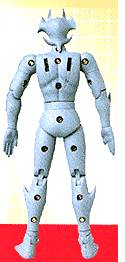![[Alen Yen's ToyboxDX]](images/smlogo.gif)
![[Eau de Alt]](libalt/eaumast.gif)
First there was nothingness.
Then there was diecast.
The year is 1972. After several thousand years of relatively
unproductive civilization, humanity had finally created its greatest
achievement: diecast character toys. Nagai Go is to blame for the
birthing of cho-go-kin Z, the fetishization of a simple zinc alloy that
has wowed us, plagued us, teased us, nibbled us, and caressed us for the
past twenty years. The advent of plastic in the early '80s seemed to be
the nail in the coffin of carefully-crafted diecast toys, but lo and
behold -- they're baaa-aack!
1998 has been a watershed year for diecast. Although a few small
small operations had
been churning out nostalgic
, cho-go-kin style pieces, it
wasn't until Bandai's Soul of Chogokin series in late '97 that the
flaming ball of lust that is diecast nostalgia really began spinning in
earnest. Hobby Project, who had cut their teeth on a very limited-run
Geki-Ganger III diecast toy, burst forth with a run of Mazinger Z Boss
Borott. Nostalgic Heroes produced their beautiful and under-appreciated
Side Machine, Kikaider and Hakaider toys. Banpresto sold tiny,
deformed "hot-blooded-go-kin" super-robot diecasts through arcade
claw-machines. Bandai released it's Black Mazinger Z and Great Mazinger.
And now Marmit Toy has stepped onto
the scene.
Marmit's pre-painted, large scale soft vinyl figures of super robots put
them on the nostalgic-toy map. On the heels of the international success
of this series, Marmit has announced that they are planning to release a
"standard-size" chogokin of none other than Devilman, yet another
wildly-popular anime character that somehow skated through the '70s
without having a single diecast toy ever made of it.
Known as a "Dynamic Go-kin," this Devilman piece is something of a
test-bed for Marmit. If it is successful, they plan to round out the
line with more additions, creating a diecast analogue to Kaiyodo's
aptly-named "Violence Action Figure" lineup. The really fascinating
thing about Marmit's Devilman is the sheer amount of detail: by mixing
in vinyl and ABS plastic parts, everything down to Devilman's toes are
articulated, and the proportioning of the figure is definitely '90s
rather than '70s. (Don't worry, though: the main body, upper arms, and
legs are all solid metal.) The only snag is the price: at 9,800 yen
($85) a pop, it's almost a guarantee that they'll retail for well over
$100 in the 'States.
Thus the double-edged sword of new diecast toys: kids these days don't
want 'em, so they're aimed at adult collectors. Collectors who'll pay
anything to round out their collections. It's like shooting fish in a
barrel -- fish with a sense of nostalgia and large amounts of disposable
income. (Huh?) Yes, I'm talking about you. Hey, you wanted it, and now
you've got it: the chance to buy diecast toys just as you did when you
were a kid. In an ironic Twillight-Zone-esque twist, however, the prices
have been SCALED UP IN PROPORTION TO YOUR CURRENT INCOME! So they're
just as tough to get NOW as when you had to scrape the $20 together as a
kid! Ah-hahahahaha! Excuse me while I step outside and blow my brains
out.
I'd like to give a shout-out to Hyper Hobby Magazine (where this pic
came from), the publication that's rapidly eclipsing Hobby Japan for its
sheer amount of juicy toy-gossip. Sure, it's a tool of the Man (Bandai),
but then again what ISN'T in Japan, y'know?
 12/03/98: Die-cast Renaissance
12/03/98: Die-cast Renaissance
--M.A.